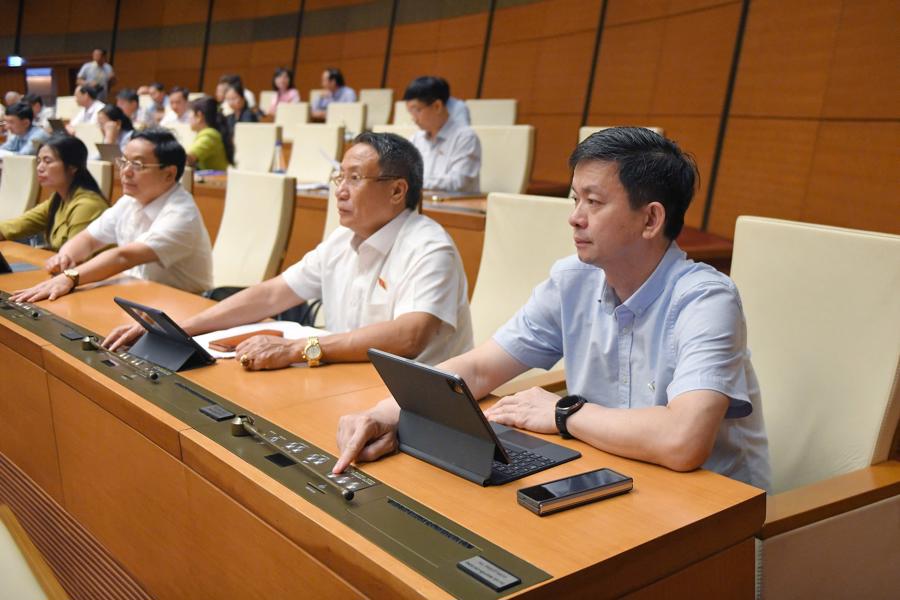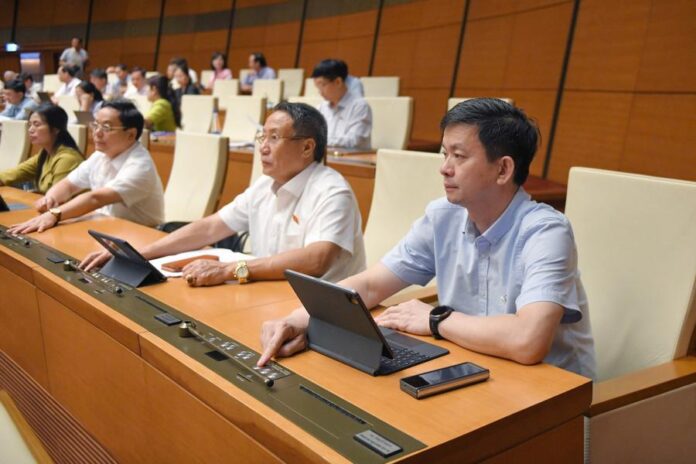On June 14, 2025, the National Assembly officially passed the Law on Digital Technology Industry. The Law on Digital Technology Industry is not only a specialized law but is also expected to be an institutional lever for the national digital transformation process.
This is a golden opportunity for Vietnam to proactively build a legal foundation, paving the way for the solid development of domestic technology enterprises, deep integration, and contributing to Vietnam’s new position in the digital age. Vietnam also becomes the first country in the world to issue a separate law on the field of the digital technology industry.
BUSINESS CONDITIONS FOR PROVIDING DIGITAL ASSET SERVICES
The Law stipulates the development of the digital technology industry, the semiconductor industry, artificial intelligence, digital assets, and the rights and responsibilities of agencies, organizations, and individuals concerned.
Explaining, synthesizing, and editing the draft Law on Digital Technology Industry, Mr. Le Quang Huy, Chairman of the Science, Technology, and Environment Committee, informed: Regarding digital assets, some opinions suggested that it is necessary to build a legal framework for digital assets that details the core issues, immediately identifying the contents to be implemented (property rights, ownership, transactions, confidentiality, responsibilities, dispute resolution, risk management, etc.), while ensuring unity with the current legal system and international practices and establishing a management mechanism. Supervision and risk prevention; clarify whether digital assets can be used for exchange or investment purposes; and clarify the content and criteria for classifying digital assets.
The National Assembly Standing Committee believes that according to the draft law, digital assets are defined as assets under the current Civil Law. Property rights, ownership, transactions, confidentiality, responsibilities, dispute resolution, risk management, etc., have been adjusted according to the provisions of criminal law, the Law on Anti-Corruption, Anti-Money Laundering, and relevant laws.
Therefore, to ensure the feasibility, flexibility, and stability of the legal system, the draft Law only provides principles on this issue and assigns the Government to specify details appropriate to the practical development situation.

Synthesizing the opinions of the National Assembly deputies, the draft Law has specified more concretely some core contents in the State management of digital assets (including the creation, issuance, storage, transfer, establishment of ownership of digital assets; the rights and obligations of the parties related to activities associated with digital assets; measures to ensure information security, cybersecurity; prevention of money laundering, prevention of terrorism financing, prevention of the financing of weapons of mass destruction; inspection, handling of administrative violations; business conditions for the provision of encrypted asset services, etc.)
At the same time, assigning the Government to detail the authority, content management, and classification of digital assets suitable to the reality and management requirements in the fields and branches.
The Law clearly defines: Digital assets are assets as prescribed by the Civil Code, manifested in digital data form, created, issued, stored, transferred, and authenticated by digital technology in the electronic environment.
According to this Law, digital assets include: Virtual assets in the electronic environment are a type of digital asset that can be used for exchange or investment purposes. Virtual assets do not include securities, digital forms of legal tender, and other financial assets as prescribed by civil and financial laws;
Encrypted assets are a type of digital asset that uses encryption technology or similar digital technology to authenticate assets in the process of creation, issuance, storage, and transfer. Encrypted assets do not include securities, digital forms of legal tender, and other financial assets as prescribed by civil and financial laws; and other digital assets.
NINE POLICIES FOR DEVELOPING THE DIGITAL TECHNOLOGY INDUSTRY
The Law also stipulates nine policies to develop the digital technology industry, including:
First, mobilize resources for investment in research, development, design, and technology transfer; gradually master digital technology; build a shared regional and national-scale digital technology industry infrastructure to promote the activities of the digital technology industry.
Second, train and develop human resources for the digital technology industry; develop educational institutions and vocational educational institutions specializing in digital technology; have special preferential mechanisms to attract and retain high-quality human resources and digital technology talents.
Third, have a controlled trial mechanism for products and services that apply digital technology in industries and fields, including a mechanism to exclude responsibility for agencies, organizations, businesses, and individuals in trials.
Enterprises implementing semiconductor chip design projects are supported with training costs for human resource development, research and development, pilot production, purchase of machinery, equipment, technology, and technology innovation from the local budget according to the provisions of the Law on State Budget or from the financial sources for the development of the digital technology industry stipulated in this Law. The Provincial People’s Council shall prescribe the criteria, conditions, order, procedures, contents, and levels of support from the local budget for the contents specified in this Clause suitable to the conditions of the locality.
Projects for the production, packaging, and testing of semiconductor chip products are allowed to import used technology lines, machinery, equipment, and tools that directly serve production activities that meet the criteria prescribed by law.
Fourth, have preferential mechanisms in land, credit, taxes, and other preferential mechanisms in research, testing, development, production, and application of digital technology products and services.
Fifth, develop the market for the digital technology industry; have mechanisms for ordering, prioritizing investment, leasing, and purchasing digital technology products and services using state budget capital.
Sixth, develop digital data in the activities of the digital technology industry into important resources and production materials and a foundation for research, development, and promotion of the digital technology industry.
Seventh, promote the development and application of artificial intelligence in industries and fields and all aspects of socio-economic life; make artificial intelligence a new production method; strongly promote national endogenous capacity, creating new economic models with superior productivity and value. The State shall have the highest preferential policies to promote the research, development, deployment, and use of artificial intelligence.
Eighth, have superior preferential policies to develop the semiconductor industry and form a Vietnamese semiconductor ecosystem.
Ninth, develop the digital technology industry sustainably, using energy-saving and efficient energy, and minimizing negative impacts on the environment.
INCREASING THE NUMBER OF DIGITAL TECHNOLOGY INDUSTRY ENTERPRISES TO 150,000 BY 2035
To build a strong ecosystem of digital technology enterprises with a target of 150,000 enterprises by 2035, the law provides comprehensive support policies. Small and medium-sized enterprises are supported with infrastructure investment costs, high-quality human resource training, and priority in bidding for public procurement projects.
In terms of finance, the State supports investment capital for special projects and innovation funds to help enterprises improve their creativity and competitiveness. Industrial production projects in the field of digital technology and auxiliary enterprises enjoy tax incentives similar to those in extremely difficult areas, while attracting foreign investment to enhance production capacity. Developing digital technology industrial parks with attractive incentives creates an environment for startups to grow sustainably, contributing to the realization of this strategic goal.
The Digital Asset Revolution: Unlocking the Government’s Vision
The recently passed Digital Technology Industry Law by the legislature has garnered attention for its progressive approach. With a focus on developing a robust digital technology and artificial intelligence workforce, the law introduces a forward-thinking policy. Additionally, it establishes a legal framework for managing digital assets, showcasing a comprehensive understanding of the modern landscape.
From the Han River Miracle to the International Financial Center: “Da Nang Can Emulate Dubai”
Within just one year, from 2022 to 2023, the UAE has successfully attracted billions of dollars in additional investment into the digital asset sector. As a result, Dubai has witnessed a significant influx of businesses operating within this space, solidifying its position as a leading hub for digital asset enterprises.





















